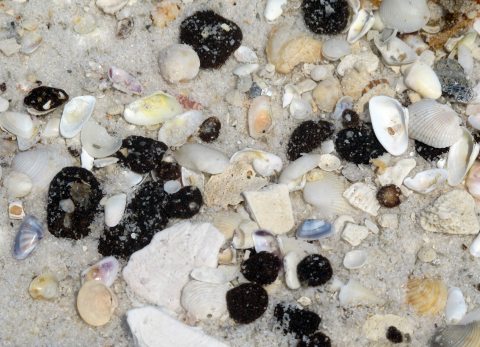Have you seen this? BP is out to win the hearts and minds of Gulf Coast residents with upbeat videos on YouTube. Everything is great! Based on the comments I’ve read so far, it doesn’t look like their campaign is having much success.
Recent news accounts also paint a more nuanced picture of Gulf Coast “recovery”: BIRMINGHAM, Ala. — Tar balls washed onto Gulf of Mexico beaches by Tropical Storm Lee earlier this month show that oil left over from last year’s BP spill isn’t breaking down as quickly as some scientists thought it would, university researchers said Tuesday.

In this Sept. 14, 2011 file photo, seashells and tar balls are washed up along Gulf Islands National Sea Shore near Pensacola Beach, Fla. Tar balls washed onto Gulf of Mexico beaches by Tropical Storm Lee earlier this month show that oil left over from last year's BP spill isn't breaking down as quickly as some scientists thought it would, university researchers said Tuesday. (AP Photo/Melissa R. Nelson, File)
Tar balls wash ashore and get a few mentions in the local press. Scientists don’t know what long term impact all the submerged oil and dispersants will have on the ecosystem. But drilling has resumed, BP is making uplifting videos and if we didn’t know better we could be forgiven for thinking that everything is just fine.
Update:
By Kelli Dugan
MOBILE, Alabama | Wed Sep 21, 2011 1:57am EDT
(Reuters) – Auburn University researchers said oil mats submerged in the seabed more than a year after the biggest oil spill in U.S. history pose long-term threats to coastal ecosystems across the northern Gulf of Mexico.
The study, released on Tuesday by the school’s engineering department, showed that tarballs churned to the surface by Tropical Storm Lee and deposited along Alabama beaches this month had “essentially identical” chemical composition as samples taken from mats after the Deepwater Horizon oil spill.
“Our interpretation of these observations is that submerged tar mats buried offshore of this coastline are breaking apart to yield these tar balls,” the study reads, estimating the tarballs in question contained about 17 percent oil by mass.
The civil engineering study — conducted prior to, during and after the tropical storm’s landfall on Alabama beaches — indicated the spill’s remnants remained largely unchanged 17 months after the Deepwater Horizon oil rig exploded and sank off the coast of Louisiana.
The data directly linked the recently deposited tarballs to the 2010 event that resulted in more than 200 million gallons of oil spewing into the Gulf of Mexico from BP PLC’s Macondo well.
“The data question the validity of the widely held belief that submerged oil from the Deepwater Horizon accident is substantially weathered and thus depleted of most polycyclic aromatic hydrocarbons,” the study said.
“Also, it supports the hypothesis that submerged oil may continue to pose some level of long-term risk to nearshore ecosystems,” it said.
The study added that the tropical storm had demonstrated the “potential for remobilization” by similar storm events in the future but said the magnitude of such events could not be anticipated with any level certainty.
BP spokesman Scott Dean said the Auburn research has not had any immediate impact on the oil company’s ongoing response to the spill.
“We’re looking at the study, but it doesn’t change our commitment to the response,” Dean said. “We’ll continue to have crews out collecting tarballs as the reports come in.”
Specifically, BP dispatched Shoreline Cleanup Assessment Technique teams to the affected areas following Tropical Storm Lee and provided additional manual cleanup personnel to “augment existing cleanup operations.
The SCAT teams consist of an environmental lead, a safety lead and representatives from the U.S. Coast Guard, Alabama Department of Environmental Management and BP.
(Editing by Cynthia Johnston)
